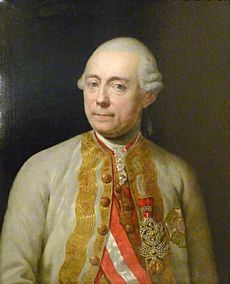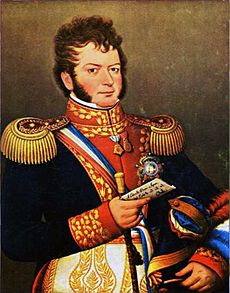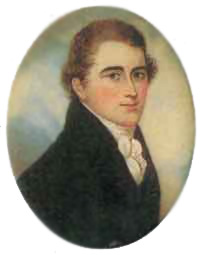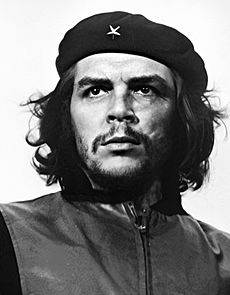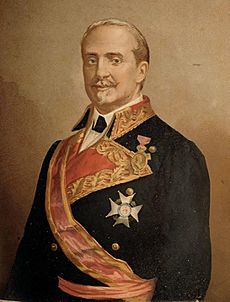Irish military diaspora facts for kids
The Irish military diaspora is about the many people from Ireland, or those with Irish family roots, who have served in armies and navies around the world. These brave individuals served in many different countries, no matter their rank or how long they served.
Often, military groups overseas were mostly made up of Irish people. Some even had "Irish" or an Irish place or person's name in their unit's title. These "Irish" units fought in many wars throughout history. The very first known Irish military unit was in the Spanish Netherlands during the Eighty Years' War between Spain and the Dutch. A famous example is Owen Roe O'Neill.
Contents
- Irish Soldiers in Australia and New Zealand
- Irish Soldiers in Austria and Austria-Hungary
- Irish in Great Britain's Military
- Irish Soldiers in Canada
- Irish Soldiers in France
- Irish Soldiers in Germany
- Irish Soldiers in Latin America
- Irish Soldiers in the Papal States
- Irish Soldiers in Portugal
- Irish Soldiers in Russia
- Irish Soldiers in Sweden
- Irish Soldiers in South Africa
- Irish Soldiers in Spain
- Irish Soldiers in the United States
- Images for kids
Irish Soldiers in Australia and New Zealand
During the 1800s, the British colonies of Australia and New Zealand worried about possible attacks from countries like France and Russia. By 1870, British soldiers left, and local forces had to defend the colonies.
New Zealand's Irish Units
Many Irishmen were among the British soldiers who settled in New Zealand in 1847. The first Irish military unit in New Zealand was the Christchurch Royal Irish Rifle Volunteers. It started on November 18, 1868. This unit was later renamed and then ended on August 11, 1874.
On April 29, 1885, 95 Irish community members in Christchurch wanted to form a new Irish volunteer group. This was approved the next day as the Canterbury Irish Rifle Volunteers.
Another group, the Dunedin Irish R.V., formed on May 7, 1885, with 189 men. They became part of the 1st Battalion Otago R.V. in 1886 and were later disbanded. The Southland Irish R.V. also formed in Invercargill on June 10, 1885, but it was disbanded about a year later.
In 1885, during another "war scare," a group called the Temuka Irish Rifles was suggested, but the idea was dropped when the government decided there wouldn't be a war.
The Auckland Royal Irish R.V. was accepted on June 24, 1887. By October 1889, they had 93 officers and men. This unit was disbanded on March 5, 1892.
The last Irish unit in New Zealand was the Irish R.V. (Wanganui), accepted on October 22, 1901. They were part of the 2nd Battalion Wellington (West Coast) R.V.
In 1911, a new law ended the volunteer system. The Wanganui Irish unit became part of the new territorial system.
Later, the Nelson, Marlborough, and West Coast Regiment started wearing an Irish hat called a "Caubeen." This was because they formed a special link with the Royal Irish Fusiliers in 1949. The blue caubeen and green feather (hackle) were officially given to the New Zealand regiment in 1961. By the early 1990s, all soldiers in the unit wore the caubeen and hackle. However, due to money problems, the caubeen was stopped in the 1990s and replaced by a green beret. In 1998, a new "lemon-squeezer" hat was introduced for formal events. The green hackle is still worn to show their connection with the Royal Irish Regiment.
Australia's Early Irish Units
Queensland's Irish Corps
In 1862, an offer to form an Irish unit in Queensland, Australia, was turned down.
Eighteen years after New Zealand's first Irish unit, a Queensland Irish Volunteer Corps was suggested on February 18, 1887. It was officially formed on February 24, 1887, as 'A' Company Queensland Irish Rifle Corps.
This unit started in South Brisbane with three officers and 100 soldiers. Soon, 'B' and 'C' companies were formed in other parts of Brisbane. 'D' Company was formed in Gympie in 1888, and 'E' Company in Ipswich in 1889. 'F' Company was also formed in East Brisbane at the same time. The last company, 'G' Company, was raised in Maryborough in December 1889.
An attempt to form an Irish unit in Rockhampton in March 1887, with over 100 volunteers, did not happen.
'G' Company in Maryborough was the first to disband in 1891, followed by 'D' Company in Gympie in 1894. In 1896, the Queensland Irish Volunteer Corps was renamed the 3rd (Queensland Irish) Battalion. By August 1898, all these volunteer units in Queensland had disbanded.
New South Wales Irish Rifles
In November 1895, a meeting in Sydney decided to form an Irish Rifle Corps. These companies were officially formed on March 5, 1896, as the New South Wales Irish Rifles. They joined with other units to form the 5th (Union Volunteer) New South Wales Infantry Regiment. Another Irish company was formed in Sydney in 1998.
On July 1, 1899, these national companies formed their own regiments. The Irish unit was renamed the 8th Union Volunteer Infantry Regiment (Irish Rifles). Two non-Irish companies were attached for administrative reasons. A new Irish Company was formed in Newcastle in June 1900.
Twenty-three men from the 8th (Irish Rifles) fought in the Boer War. The 8th Union Volunteers Infantry Regiment (Irish Rifles) was renamed the NSW Irish Rifle Regiment (Volunteers) in 1903. It became the 1st Battalion NSW Irish Rifle Regiment in 1908.
Major changes in 1912 led to the name 33rd Infantry Regiment, and in 1918, it became the 55th Battalion. In 1927, the old NSW Irish Rifles name was brought back. The "Irish connection" finally ended in 1930 when the regiment was renamed the NSW Rifle Regiment.
South Australia's Irish Company
On February 13, 1900, a public notice in the South Australian Register called for a meeting to form an Irish Rifle Corps. 157 volunteers signed up. After selection, they became 'F' (Irish) Company, 1st Battalion Adelaide Rifles.
They wanted to wear a green uniform, but this was not allowed. However, they wore a shamrock made of black braid on their sleeves and brass harp badges on their collars. These special badges were worn until January 1910, when they were ordered to stop wearing them. This was to make their uniforms look the same as other companies. A green stripe on their trousers was also approved but later disallowed.
Victoria's Proposed Corps
In April 1885, there were attempts to form an Irish Australian Volunteer Corps of 500 men in Melbourne, Victoria. Several meetings were held, but the corps was never formed.
Australia After Federation
When the Australian Commonwealth military forces were created in 1903, the Adelaide Rifles became part of the 10th Australian Infantry Regiment. This was the last Irish unit formed in Australia.
There were other attempts to form Irish Australian regiments in Melbourne in 1901 and 1910, and again in 1941. An Irish Volunteer Corps was suggested in Perth, Western Australia, in 1900 and again in 1904. An Irish regiment was also suggested in Bendigo, Victoria, in 1906. A company of Irish Rifles was considered in Broken Hill, NSW, in 1910. An Irish corps was also proposed in Queensland in 1906. Committees were often set up, but these units were never actually formed.
The 4th Battalion, Royal Australian Regiment (4 RAR), was formed in 1964. It is linked to Britain's 4th Regiment of Foot Guards (The Irish Guards). The 4 RAR band wears the same uniform as the Irish Guards' Pipes and Drums. This battalion served in Malaysia and Borneo, fighting the Indonesian army. It also served two tours in Vietnam. From 1990 to 1993, soldiers from the battalion served with the United Nations in Cambodia. In 1993, they went to Somalia, and in 1994, to Rwanda. In 1996, 4 RAR became a special forces unit, renamed 4 RAR (Commando) in 1997. This unit has served in East Timor, Iraq, and Afghanistan, where some soldiers were killed in action.
Irish Soldiers in Austria and Austria-Hungary
The Habsburg family (who ruled a large empire in Central Europe) often hired Irish soldiers. Their empire had many different nationalities, so talented foreigners were always welcome. It's believed that over 100 Irishmen became high-ranking officers like field marshals or generals in the Austrian Army.
One of the first important Irishmen to serve the Habsburgs was Colonel Richard Walsh from Dublin. He was badly wounded in the Battle of Lützen. His son, Oliver, became a Major-General. In total, eleven members of this family became field marshals or generals, with George Olivier, count of Wallis being the most famous.
Many Irishmen became colonels who commanded regiments. Jacob Butler was the first. Another Walter Butler was praised for defending Frankfurt an der Oder. This Butler was also responsible for the killing of the Bohemian general Albrecht von Wallenstein.

Baron Dermot Kavanagh († 1739) from Ballyane, County Wexford, served in the Imperial Army from a young age. He fought in Hungary, Italy, and Flanders. He was also a Kämmerer (Chamberlain) at the royal court in Vienna. In 1723, he bought the manor of Hauskirchen in Lower Austria. From 1727 to 1734, he commanded the Czech Dragoon Regiment No. 7 as a colonel. He was promoted to general in 1734 and 1735. He died in 1739 from wounds received during the siege of Belgrade. Kavanagh and his wife are remembered with a monument in the church at Hauskirchen.
Maximilian Ulysses Browne was born in Austria but came from a famous Irish family from Limerick. He became a major-general by age 30 and rose to the rank of Generalfeldmarschall. He died leading his men in the Battle of Prague. Browne was a relative and mentor to Franz Moritz von Lacy (son of Peter Lacy), who became head of the War Council from 1766 to 1774.
Other famous Irish-Austrian generals included William O'Kelly from Co. Galway, and John Sigismund Maguire of Co. Kerry, who captured Dresden in 1758. General Karl O'Donnell was known for his excellent actions at the Battle of Torgau. Colonel Hume Caldwell from Co. Fermanagh was noted for his bravery at Breslau and Olmütz, where he died. Field Marshal Laval Nugent von Westmeath was important during the Napoleonic Wars. He was famous for capturing Rome in 1815, and for this, the Pope made him a prince in 1816. There were no specific Irish regiments in the Austrian Army; Irish influence was mainly through noble officers.
Here are some notable Irishmen who served in the Austrian military:
- Franz Moritz Graf von Lacy
- Maximilian Ulysses Graf von Browne
- Laval Graf Nugent von Westmeath
- Maximilian Graf O'Donnell von Tyrconnell
Irish in Great Britain's Military
Many Irish people have served in the British military over hundreds of years. By the late 1700s and early 1800s, more than one-third of the British Army was made up of Irishmen. This was for several reasons:
- Ireland was linked to the British Crown for a long time.
- After 1800, Ireland became part of the United Kingdom of Great Britain and Ireland.
- For noble families, military service was a respected career choice.
- Many joined because they needed work or wanted to achieve great things.
- It was often a family tradition.
Many Irishmen had important careers in the British forces:
- Rear Admiral Francis Beaufort
- Marshal of the Royal Air Force Sir Dermot Boyle
- Lieutenant-General Sir William Butler
- Admiral of the Fleet Sir George Callaghan
- Guy Carleton, 1st Baron Dorchester
- Field Marshal Viscount Gough
- Field Marshal Lord Kitchener
- Paddy Mayne
- The Duke of Wellington (a famous Field Marshal)
Others were born into Irish families but not in Ireland itself:
Victoria Cross Recipients
The Victoria Cross is Britain's highest award for bravery in the military. 188 people born in Ireland or with full Irish parents have received this award.
- 30 were awarded during the Crimean War.
- 52 were awarded during the Indian Mutiny.
- 46 were awarded in other British Empire campaigns between 1857 and 1914.
- 37 were awarded in the First World War.
- 10 were awarded in the Second World War.
- One was awarded in the 21st century in Afghanistan to a soldier from Belfast.
British Army Units with 'Irish' in their Name
Many British Army units have had "Irish" in their name, showing their strong connection to Ireland.
- The Royal Northumberland Fusiliers started as "The Irish Regiment" in 1674.
- Irish Guards (still active today).
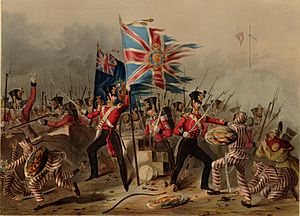
- Royal Inniskilling Fusiliers
- Royal Irish Fusiliers
- Royal Ulster Rifles
- Royal Irish Rangers
- Royal Irish Regiment (still active today).
- London Irish Rifles
- Liverpool Irish
- Royal Irish Artillery
Irish Units Disbanded in 1922
After the Irish Free State became independent in 1922, six British Army regiments that recruited mainly from southern Ireland were disbanded. Their flags (Colours) were laid up in a special ceremony at Windsor Castle on June 12, 1922. These regiments were:
- Royal Irish Regiment
- Connaught Rangers
- Leinster Regiment
- Royal Munster Fusiliers
- Royal Dublin Fusiliers
- South Irish Horse
Many soldiers from these disbanded regiments later joined the new National Army of the Irish Free State.
Irish Soldiers in Canada
The Irish Regiment of Canada was the only Canadian Irish unit to fight in the Second World War. Other Canadian Irish units also served in the First World War.
Some Canadian Army units with "Irish" in their name include:
- The Irish Canadian Rangers
- The Irish Fusiliers of Canada (The Vancouver Regiment)
- The Princess Louise Fusiliers: Even though "Irish" isn't in their name, they are an Irish regiment. They wear a blue Caubeen (an Irish hat) with a grey feather.
- The Irish Regiment of Canada
Irish Soldiers in France
The Irish Brigade served the French kings from 1690 to 1792. These soldiers were known as "Wild Geese."
Notable Irishmen who served in the French military include:
- Patrice de Mac-Mahon, Duke of Magenta – A General who later became the President of France.
- Thomas Arthur, comte de Lally – A General who commanded French armies in India.
- Henri Jacques Guillaume Clarke – A Marshal of France.
French Army Units with 'Irish' in their Name
Many regiments in the French Army were part of the Irish Brigade:
- Irish Brigade
- Régiment de Berwick
- Régiment de Clare
- Régiment de Dillon
- Régiment de Walsh
- Irish Legion (1803–1815)
Irish Soldiers in Germany
Bavaria
During the War of the Spanish Succession, Irishmen made up 8% of the Bavarian army's officers. The ruler of Bavaria, Maximilian, also governed the Spanish Netherlands and appointed Irish officers to his regiments.
Unified Germany
During the First World War, Imperial Germany tried to create an "Irish Brigade" from Irish prisoners of war who had served in the British Army. However, by 1916, only 52 men volunteered, and the plan was stopped.
In the Second World War, an even smaller number of Irishmen volunteered to join the German army (the Wehrmacht). Some IRA supporters also planned secret operations with German intelligence, but these were mostly unsuccessful.
Irish Soldiers in Latin America

Irish people played a big role in the history of many Latin American countries, especially during their fights for independence.
Notable Irish People in Latin American Military History
- William Brown (admiral) – Known as the "Father of the Argentine Navy."
- Peter (Pedro) Campbell – Founded the Uruguayan Navy.
- John Deveroux – Commander of the Irish Legion in Venezuela.
- Che Guevara – A famous revolutionary in Cuba who had Irish family roots.
- Juan MacKenna – Founded the Military Corps of Engineers of the Chilean Army.
- William Lamport – Nicknamed "El Zorro" (The Fox) for his adventures in Mexico.
- Bernardo O'Higgins – The first head of state of Chile (Supreme Director, 1817–23). He led the forces that won Chile's independence from Spain. His father, Ambrosio O'Higgins, was a colonial governor.
- Daniel Florencio O'Leary – An aide to Simón Bolívar, a key leader in South American independence.
- Alexander O'Reilly – A General known as the "Father of the Puerto Rican Militia."
- John Riley – Commander of the Saint Patrick's Battalion during the Mexican–American War.
Irish Units in Latin America
- 1st Regiment Venezuelan Rifles – An Irish regiment that fought in the Venezuelan War of Independence.
- Saint Patrick's Battalion – An Irish American battalion that fought for Mexico in the Mexican–American War.
Irish Soldiers in the Papal States
The Irish who went to fight for the Papal States were volunteers, not professional soldiers. They wanted to defend Pope Pius IX. In 1860, it was becoming harder for foreign countries to recruit soldiers in Ireland, but it was still possible.
These Irish volunteers were not well-clothed or equipped, but they fought bravely. In the battle of Perugia, after most of the Papal forces surrendered, the Irish continued to fight. In the battle of Spoleto, 300 Irish volunteers led by Myles O'Reilly held off 2,500 experienced Italian soldiers for fourteen hours, including fierce hand-to-hand combat.
Another important battle was Battle of Castelfidardo, where 150 Irishmen fought. The war ended soon after, when the Papal army, outnumbered and out-equipped, was ordered by the Pope to surrender.
Besides Myles O'Reilly, this was the first military experience for Myles Keogh. He later fought bravely in the American Civil War and then with the United States Cavalry. He died at the Battle of Little Bighorn in 1876.
Irish Soldiers in Portugal
- Marshal William Beresford, 1st Viscount Beresford; he was the head of the Portuguese army from 1809 to 1820.
Irish Soldiers in Russia
The most famous Irishman to serve in the Russian Army was Peter Lacy from Bruff, County Limerick. He died in 1751 while serving as governor of Livonia. Lacy's daughter married another Irishman, General George Browne, who also became a Russian general. Their son, Johann Georg von Browne, also reached the rank of general in Russia.
Count John O'Rourke was an important military thinker during the time of Catherine the Great. O'Rourke and his brother Cornelius joined the Russian Army. John O'Rourke's son, Joseph Cornelius O'Rourke, became a lieutenant general during the Napoleonic era.
Irish Soldiers in Sweden
Irish military involvement in the Swedish army was not very successful. In the early 1600s, about 6,000 Irishmen were sent to Sweden. They were unhappy fighting for a Lutheran country. Some Irish priests disguised themselves as soldiers and encouraged the men to leave and join Catholic armies instead. Most of them left Swedish service and joined the army of Poland. After this, Gustavus Adolphus, the Swedish king, refused to recruit large numbers of Irishmen, as he considered them untrustworthy. However, a small number of Irish officers did serve in the Swedish army.
Irish Soldiers in South Africa
Some Irish people fought in British armies during various colonial wars in South Africa. Some Irish were also among the settlers who arrived in 1820. A famous example is the Rorke family, whose descendants later established Rorke's Drift, a site of a famous battle.
Irish Units in South Africa
- South African Irish Regiment (Formed in 1914 and still active).
Irish Soldiers in Spain

The first large group of Irishmen went to serve in Spain after the failure of the Second Desmond Rebellion in 1583. At least 200 Irish were part of the Spanish Armada in 1588. Around the same time, in 1587, 600 Irishmen led by Sir William Stanley, who were sent to help the Dutch, switched sides and served Spain instead.
Another large group of Irishmen joined Spanish armies after the Siege of Kinsale. An Irish regiment was formed in 1605, led by Colonel Henry O'Neill. Five more Irish regiments were formed between 1632 and 1646. However, problems from Ireland, like tensions between different Irish families, continued in Spain.
After the Cromwellian conquest of Ireland, many more Irishmen left Ireland. This suited the English, as it meant fighting-age men would be busy in wars on the continent. In 1653, during the Siege of Girona, some Irish defenders even left and joined the French army. When Charles II became king in 1660, most of the remaining Irish soldiers returned home.
During the War of the Spanish Succession in 1701, Irish regiments were reformed, mostly through France. Two dragoon regiments and four infantry regiments were formed. They wore red uniforms until 1802, when they changed to light blue like the rest of the Spanish army.
Notable Irishmen who served in Spain include:
During the Spanish Civil War (1936–1939), some Irish people fought on both sides:
- Eoin O'Duffy led the Irish Brigade (Spanish Civil War) to fight for the Nationalists.
- Frank Ryan and the Irish Socialist Volunteers fought for the Republicans.
Irish Soldiers in the United States
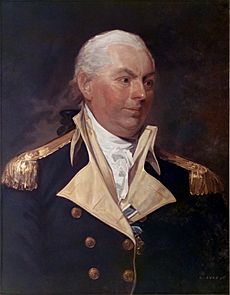
Irish people have been fighting in what is now the United States since the mid-1600s, especially in Virginia, Pennsylvania, and the Carolinas. For example, Florence O’Sullivan, an early settler in South Carolina, was involved in many fights against the Spanish and Native Americans near Sullivans Island.
In the 1700s, many Irish surnames appeared on colonial American military records. Irish involvement increased during the American Revolution and even more in the mid-1800s when many Irish immigrants came to the United States.
Notable Irish People in U.S. Military History
- Commodore John Barry – Known as the "Father of the American Navy."
- Edward Hand – A general in the American Revolution.
- Richard Montgomery – A general in the American Revolution.
- Philip Sheridan – A famous Union general in the American Civil War.
- James Shields – A Union general who helped defeat General Thomas "Stonewall" Jackson at Kernstown in 1862.
- Myles Walter Keogh – Fought in the American Civil War and later died at the Battle of Little Bighorn.
- Michael Mullen – Chairman of the Joint Chiefs of Staff from 2007-2011.
- Martin Dempsey – Chairman of the Joint Chiefs of Staff from 2011-2015.
Confederate States of America
Some Irish people also fought for the Confederate States during the American Civil War:
- Patrick Cleburne – A Confederate general.
- Richard W. Dowling – A Confederate officer.
'Irish' Named Units in the United States
Many of these units were formed during the American Civil War.
American Revolution
- Loyal Irish Volunteers (fought for the British)
- 2nd American Regiment (Volunteers of Ireland)
American Civil War Union Army
- 69th New York Volunteer Infantry ("Fighting 69th"): This unit still exists today as an Army National Guard battalion and keeps its Irish traditions.
- Irish Brigade (US): A famous group of Irish-American regiments.
- 9th Massachusetts Volunteer Infantry
- 10th Ohio Volunteer Infantry
- 28th Massachusetts Infantry
- 35th Indiana Volunteer Infantry ("1st Irish")
- 37th New York Volunteer Infantry ("The Irish Rifles")
- 164th New York Volunteer Infantry ("Corcoran's Irish Zouaves")
Confederate Army
- 1st Irish Battalion, Virginia Infantry Regulars
- 6th Louisiana Volunteer Infantry ("Irish Brigade")
- 10th Tennessee Volunteer Infantry ("Sons of Erin")
- Louisiana Tigers (included many Irish soldiers)
Images for kids
-
Http://www.diggerhistory.info/pages-badges/nz-vols2.htm
Canterbury Irish Rifle Volunteers badge
-
Http://www.planetfigure.com/threads/australia-nsw-irish-rifle-regiment-1900.79431/
NSW Irish Rifle Regiment, 1900
-
Http://www.diggerhistory.info/pages-conflicts-periods/other/irish rifle.htm
NSW Irish Rifles – belt-buckle
-
Https://harrowercollection.com.au/33rd-infantry-regiment/
Badges of the 8th Union Volunteers Infantry Regiment (Irish Rifles)
-
Https://sites.google.com/site/irishregimentsoftheempire/australia-and-new-zealand
NSW Irish Rifles ('Vice Regal' cigarette-card)
-
Https://sites.google.com/site/irishregimentsoftheempire/australia-and-new-
New South Wales Irish Rifles - hat badge variations
-
24rarassociation.com/?page id=1076
2/4 RAR Irish Pipes and Drums (see image 66)


